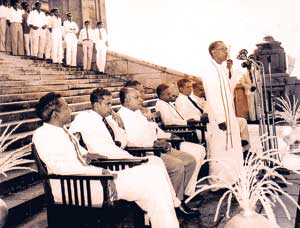Fifty years ago, on January 1, 1958, a significant event took place relating to public transport in
Sri Lanka. The nationalisation of bus
services took place on this day on a decision made by the Mahajana Eksath Peramuna government led by Prime Minister S.W.R.D. Bandaranaike.
A trip by the Prime Minister and the Minister of Transport and Works, Maitripala Senanayake in a brand new maroon luxury Mercedes-Benz bus imported from Germany marked the end of owner-bus services seen in the country ever since the first bus was imported in 1907.
 |
| Prime Minister S. W. R. D. Bandaranaike speaks at the ceremony held on the steps of Parliament (now the Presidential Secretariat) to mark the
nationalisation of bus services. |
After the country gained Independence in 1948, at least three studies had been done on the bus services. Known as the Ratnam Survey (1948), the Sansoni Survey (1954) and the Jayaratna Perera Survey (1956), all three
recommended that the companies should be nationalised.
With the nationalisation, the
management of bus services was handed over to the Ceylon Transport Board (CTB) with a respected
officer of the Ceylon Civil Service who has also operated a highly
successful private taxi service called Quickshaws, Vere de Mel as Chairman. He gave a good start to the CTB.
In the early days of the owner-operated service, there were no
government regulations in force. More than one bus operated on a
single route leading to clashes among bus operators. Their only
consideration was making profit. It was not until around 1940 that
public passenger transport in the country was regularized. Yet
conditions left much to be desired. The owners were in overall charge of operations and the companies ran the services the way they wanted. There were no time schedules or night time services. Buses packed to capacity were driven at a terrific speed.
By the time the bus services were nationalized, there were a large number of bus companies. Among the limited liability omnibus companies were the Silverline Bus Company owned by B. J. Fernando, the South Western Bus Company (Sir Cyril de Zoysa), the Ebert Silva Bus Company (Ebert Silva), Sri Lanka Omnibus Company (Jayasena Mudalali), Panadura Bus Company (Sir Leo Fernando), Wijaya Bus Company (Mudaliyar Mendis of Negombo),
K. B. L. Perera and Sons of Hendala, and Siri Medura Bus Company (Singho Mahattaya of Attanagalla).
In the formative years, the CTB ran an efficient service. At its peak, it was the largest omnibus
company in the world – with about 7,000 buses and over 50,000
employees. Whenever the leftist
parties joined the government when Mrs. Bandaranaike was Prime Minister, the Transport Ministry was given to a member of the Lanka Sama Samaja Party. First it was Anil Moonesinghe (1964).
He introduced several
measures including Workers' Councils on the Yugoslav model to
participate in management. There was a notable improvement in the morale and efficiency was seen. He expanded the bus services, most notably in Jaffna, where the
ex-London Transport double-deckers were very popular and broke the monopoly on public transport by
illicit private operators.
He set up a Central Bus Station (CBS) in Pettah, started the Central Workshops at Werahera to build bus bodies out of aluminium and carry out engine repairs and overhauls.
With a UNP government in 1965, things changed and CTB became a loss-making institution. The workers' councils were also scrapped.
In 1970, in the United Front
government, another LSSP stalwart, Leslie Goonewardena became Minister of Transport. The CTB workers immediately took matters into their own hands and
reconstituted the workers' councils. At their request, Anil Moonesinghe, who had lost the election, was brought back as Chairman and General Manager. What followed was described as 'the golden era' of the CTB.
Things changed with the
J. R. Jayewardene government in 1977. CTB was broken up into Regional Transport Boards (RTBs) and a central coordinating body, the Sri Lanka Central Transport Board (SLCTB) was established. But results were disastrous.
With the liberalised economy, import of buses was allowed
resulting in the reappearance of
unregulated private buses. Although the operators had to obtain route licences, the road
discipline of these operators was almost non-existent.
The
commuters, faced with a state transport system now on the verge of collapse, had no option but to travel on them. Most of these
private buses are in a pitiable
condition today and many are not roadworthy.
President Ranasinghe Premadasa broke the RTBs down into smaller units based on 93 bus depots, the so-called 'Peoplised Bus Companies.' The Central Workshops, Werahera and the regional workshops established in the 1970s were handed out to
private companies.
In the 1990s, the lack of success of these enterprises drove the
government to group the 93 'Peoplised Bus Companies' into 11 'cluster' companies. |

